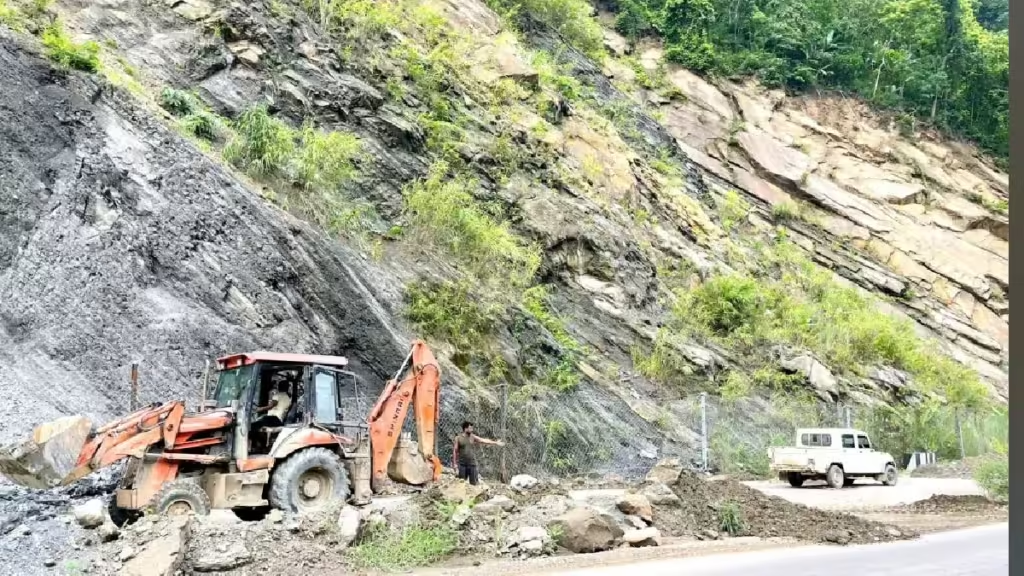The Nagaland government delivered a 72-hour ultimatum to the National Highways and Infrastructure Development Corporation Limited (NHIDCL) and its contractors. This decisive action came after a high-level meeting held in the Conference Hall of the Chief Secretary, Nagaland. The state government’s directive emphasizes the urgency of clearing debris from a crucial National Highway, which has been obstructed for an extended period.
The meeting revealed deep dissatisfaction with NHIDCL’s handling of the debris issue. The state officials expressed their frustration over the slow pace of restoration work, which has left the vital highway in a state of disrepair. This highway is a key artery for transportation and commerce, and the ongoing blockage has significantly disrupted traffic flow and daily activities for local residents and businesses.
Nagaland’s Chief Secretary, along with other senior officials, underscored the importance of the highway to regional connectivity and economic stability. The blockage has not only caused inconvenience but has also affected essential services and economic activities. The state government’s ultimatum reflects the seriousness with which it views the situation and the need for immediate action to address the problem.
NHIDCL, tasked with maintaining and developing national highways, has faced substantial criticism for its response to the situation. The prolonged delay in clearing the debris has amplified the difficulties faced by local communities, who rely on the highway for access to goods and services. The state government’s decision to impose a 72-hour deadline highlights the urgency of resolving the issue and restoring normal traffic flow.
The ultimatum sets a clear expectation for NHIDCL and its contractors to accelerate their efforts. The directive is not just about removing the physical debris but also about ensuring that the highway is safe and fully operational. This includes addressing any underlying issues that may have contributed to the blockage, such as erosion or unstable terrain, to prevent future disruptions.
In addition to the immediate focus on clearing the debris, the situation has raised broader questions about infrastructure management and disaster response. The delays in addressing the blockage highlight the need for improved processes and readiness in handling such emergencies. The state government’s intervention serves as a reminder of the importance of effective infrastructure management and the need for agencies to be prepared for rapid response to similar issues.
The 72-hour ultimatum also signals a broader commitment to accountability in public infrastructure projects. The frustration expressed by state officials and local communities reflects a growing demand for transparency and efficiency in how infrastructure issues are managed. By setting a deadline, the state government is reinforcing the need for NHIDCL to meet its responsibilities and deliver timely solutions.
As the deadline approaches, attention will be on NHIDCL’s response and efforts to clear the debris. The outcome of this situation will not only impact the immediate restoration of traffic but will also provide insights into the effectiveness of current infrastructure management practices. The resolution of the issue will be closely monitored by the state government and the public, with potential implications for future infrastructure projects and emergency response strategies.
In the broader context, the Nagaland government’s ultimatum highlights the challenges faced by infrastructure development agencies in maintaining and managing critical roadways. The focus on swift action and resolution underscores the need for ongoing vigilance and proactive measures to address infrastructure issues effectively. The state’s decisive action serves as a critical step in ensuring that essential services and connectivity are restored promptly.
Overall, the 72-hour ultimatum issued by the Nagaland government to NHIDCL represents a crucial intervention in addressing the ongoing disruption on a vital National Highway. The urgency of the situation and the need for immediate action reflect the broader implications for infrastructure management and disaster response. As efforts intensify to clear the debris and restore normalcy, the focus will be on achieving a swift and effective resolution that meets the needs of the local population and sets a precedent for future infrastructure challenges.


